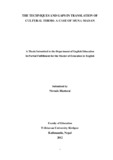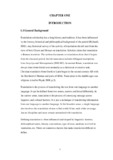Please use this identifier to cite or link to this item:
https://elibrary.tucl.edu.np/handle/123456789/724| Title: | The Techniques and Gaps in Translation of Cultural Terms: A Case of Muna-Madan |
| Authors: | Bhattarai, Nirmala |
| Keywords: | Nepali cultural;Translation;Cultural Terms;Techniques |
| Issue Date: | 2012 |
| Publisher: | Central department of English Education |
| Institute Name: | Central Department of Education |
| Level: | Masters |
| Abstract: | The present research work entitled 'The Techniques and Gaps in Translation of Cultural Terms: A Case of Muna Madan' is an attempt to find out the techniques employed in translation of Nepali cultural terms into English version of Muna Madan and to point out the gaps in translating process contextually. The data for the study was collected from Muna Madan and its English translated version. In this research work, one hundred cultural terms were identified and those terms were categorized into five categories as ecology, material culture, religious culture social culture and organization and conceptual terms. Findings of the study show that nine different techniques were found to have been employed in translating cultural words of Muna Madan. Literal translation, transference, substitution, claque, blending, deletion, and sense translation have been applied in translation of cultural words. Among them, literal translation was the most frequent one which covered 30% and deletion was the least one which covered 1% of the total cultural words. The techniques such as literal translation, transference, substitution and elaboration are found as techniques to translate the cultural terms. Very few instances of gaps were found in translation process because of the use of inappropriate techniques. In most of the cases, gaps were existed while translating through substitution. Other gaps were existed through the use of elaboration, substitution, literal, deletion and substitution. This study is divided into four chapters. Every chapter consists of necessary headings and sub headings. Chapter one introduces the study in terms of general background, review of the literature, objectives and significance of the study. Chapter two deals with the methodology under which sources of data, process of data collection and limitations of the study are presented. Chapter three is the core study, which presents statistical analysis and interpretation of the data. Descriptive and analytical approaches are used to analyze the data. Chapter four discusses the findings of the study. On the basis of findings, some x recommendations and pedagogical implications are suggested. The references are the concluding parts of the study. |
| URI: | http://elibrary.tucl.edu.np/handle/123456789/724 |
| Appears in Collections: | English Language Education |
Files in This Item:
| File | Description | Size | Format | |
|---|---|---|---|---|
| cover.pdf | 36.73 kB | Adobe PDF |  View/Open | |
| CHAPTER.pdf | 271.83 kB | Adobe PDF |  View/Open |
Items in DSpace are protected by copyright, with all rights reserved, unless otherwise indicated.
